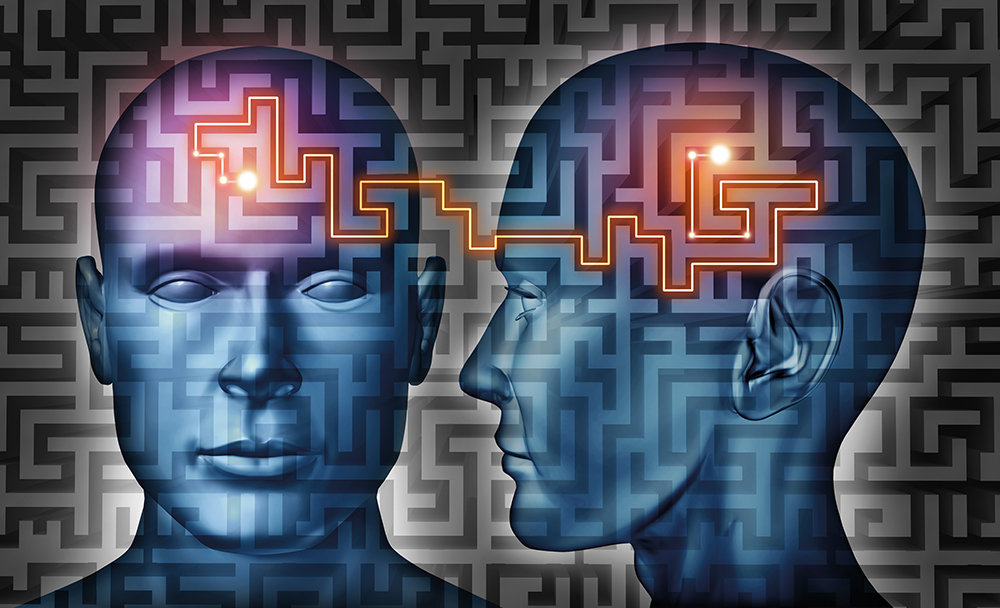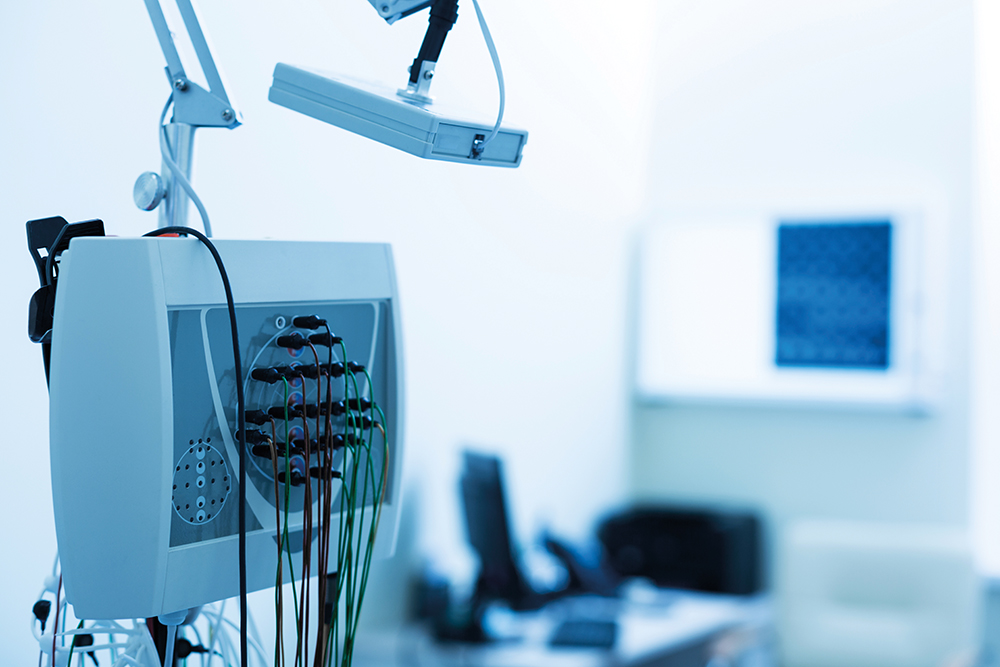Professor John F. Connolly – Breaking Through Barriers: Assessing Cognitive Function in Patients Unable to Communicate and Those with Invisible Injuries
When assessing an individual’s cognitive functioning (such as memory and sense of orientation to the environment) traditional strategies have relied on verbal and behavioural responses. But how can this be achieved if a patient is unable to communicate in this way due to impairment arising, for example, from brain injury? Professor John F. Connolly, Director of the ARiEAL Research Centre at McMaster University, Canada, and Co-Founder and Chief Science Officer at VoxNeuro, has developed an innovative neurotechnology to assess cognitive functioning in individuals that does not rely on verbal or behavioural responses.
Assessing Cognitive Function
Cognitive function underpins our mental abilities such as memory, orientation, problem-solving, reasoning, comprehension, and attention. Following a mentally debilitating event such as a stroke or brain injury, assessing a patient’s cognitive function is essential to their rehabilitation and allows healthcare professionals to determine the best treatment plan. Established tests such as the Peabody Picture Vocabulary Test and the subtests of the Wechsler Adult Intelligence Scale adapted as a neuropsychological instrument are often used to assess patients’ language and conceptual functions through verbal and/or behavioural responses. However, when patients are unable to communicate in these ways due to neurological damage, conducting these crucial assessments is either not possible, or even for patients who can engage, can have a high margin of error due to subjectivity both on the part of the patient and the healthcare professional conducting the assessment.
Professor John F. Connolly, Director of the ARiEAL Research Centre at McMaster University, Canada, and Co-Founder and Chief Science Officer at VoxNeuro, has developed a proprietary assessment method that does not rely on the need for verbal or behavioural responses from patients. This means that those patients who had barriers for being assessed accurately for cognitive function can now be assessed in an alternative way – one that is both objective and reliable.

A ‘First of its Kind’ Case Study
Aphasia is an impairment to speech and/or comprehension resulting from damage to the brain. In the early 1990s, Professor Connolly and his colleagues tested a new assessment approach in a 21-year-old patient who was characterised as globally aphasic with minimal and unreliable behavioural gestures following a traumatic brain injury (TBI) – in fact, his initial diagnosis was vegetative state.
The researchers used event-related potentials (ERPs), which are brain biomarkers, to measure specific brain response features known as components. These components reflect cognitive processes, commonly thought of as mental abilities – like attention, memory and decision making – that can be assessed even in non-communicative patients. ERPs are derived from electroencephalogram (EEG) recordings of brain responses to stimuli and the components examined have been the subject of many thousands of peer-reviewed papers, as their years of initial discovery range from 1965 to 1980.
The patient studied by Professor Connolly was severely compromised, and seemingly unresponsive to any aspect of his environment. After 3 weeks of clinical observation, it was concluded that the patient’s progression could not be assessed clinically and thus it was perceived that further intervention would not be beneficial. The patient was scheduled for discharge to a palliative care facility when he was referred for electrophysiological assessment by Professor Connolly through one of his physicians who knew of Professor Connolly’s research.
In this assessment, sentences were presented aurally with half the sentences ending with a congruous word and half with an incongruous word. For example, one congruous sentence used was ‘She could tell he was mad by the tone of his voice’ and an incongruous sentence example is ‘She went to the bakery for a loaf of sink’(with ‘sink’ replacing the congruous word ‘bread’). EEG measurements were examined separately for the sentences with congruous and incongruous terminal words in order to answer the most pressing question at the time – was the patient able to comprehend speech.
Critically, the patient’s ERP responses to spoken sentences ending with incongruous words displayed a differential response compared to sentences ending with congruous words. The researchers found that the patient’s responses were comparable to those of healthy individuals. The same sentences were presented to the patient visually, but the outcomes were abnormal and unreliable. Moreover, in comparison to healthy control participants, the readings were clearly different. The patient’s lack of brain biomarkers for comprehension to visually presented sentences was attributable to a yet-unresolved, injury-related visual abnormality.
Six weeks after the initial electrophysiological assessment by Professor Connolly, the patient was assessed again using traditional behavioural tests for attention, memory and problem-solving. However, the patient’s performance in these tests was poor. This pattern of electrophysiological responses revealing function when behavioural measures could not was the ‘first of its kind in scientific literature’ explains Professor Connolly, as they had demonstrated that the patient understood the meaning of the spoken stimuli through measuring the associated ERPs, that is, the brain biomarkers.
The team concluded that testing both visual and auditory function is important in such patients, as one function may be compromised while the other may remain intact. This work paved the way for Professor Connolly’s innovative use of ERP technology to assess cognitive functions including receptive vocabulary and semantic comprehension in patients with severe neurological impairment – functions that were once difficult or even impossible to evaluate in such patients using traditional behavioural methods.
‘The goal of my research has always been to use these new methods of assessment to identify those suffering from neuropathological conditions with greater accuracy. These methods are now being used to better inform healthcare professionals charged with treating individuals with these problems.’

Credit: JD Howell, McMaster University.
Predicting Coma Prognosis
Mismatch negativity (MMN) is an ERP component that can be described as an automatic attentional response to auditory stimuli, reflecting a predictive coding process that is below the level of conscious awareness. The presence of this particular ERP component in the prolonged state of unconsciousness known as coma has been proven to be a strong positive predictor of emergence from coma. However, the utility of the MMN as a clinical tool was compromised by its lack of sensitivity. That is, while those patients who showed the response emerged from coma, many patients who did NOT show the MMN also emerged.
Professor Connolly, along with his colleagues Dr Narges Armanfard (now at McGill University) and Professor James Reilly (McMaster University), tested a new method to detect MMN components from the ERPs of coma patients, in the anticipation of developing a more accurate predictor of coma emergence. They hypothesised that the level of consciousness waxed and waned in coma in ways that could lead to failure to see the response using traditional analysis methods, which involved recording only periodically, rather than for extended periods of time with a finer-grained analysis tool.
Traditionally, the MMN is sought in single test sessions lasting about 20 to 30 minutes. This single occasion testing reduces the likelihood of observing the MMN if consciousness does, in fact, wax and wane in coma and thus may be the cause of the low sensitivity reported in previous studies. Professor Connolly’s team proposed tackling this problem with the use of a machine learning (ML) algorithm – a localised feature selector that provided the finer-grained analysis. ML can process high-dimensional clinical data and learn complex patterns that can be too difficult to be recognised by even expert humans.
Professor Connolly and colleagues found that the use of ML accurately detected MMN over a much shorter 2-minute interval and that the MMN appeared and disappeared (the waxing-waning process) when recorded across an extended time period (e.g., 24 hours). It was found that the MMN component could be successfully detected with 92.7% accuracy in the healthy participants. Importantly, a greater similarity between the ERP responses of the coma patients and the healthy participants indicated a more positive prognosis for coma emergence. That is, the two coma patients showed high similarity levels to healthy control participants and both emerged from coma. These results, the team emphasise, are preliminary but indicate the usefulness of this new method in predicting coma emergence and possibly longer-term outcome.
More recently, Professor Connolly and his colleagues (Drs Reilly, Fox-Robichaud, Hamielec, Sonnadara (McMaster University), Tavakoli (McMaster University), Boshra (McMaster University and VoxNeuro), Blain-Moraes (McGill University) and Herrera-Diaz (PhD candidate; McMaster University) have begun a larger trial on the assessment of ERPs in coma to develop an automated procedure for analysing the ERP data with greater accuracy than the current standard clinical approach, and one that is less costly. Data will be collected from 50 individuals in coma, with EEG/ERP data collected for 24 hours at five time points over 30 days to track their progression. Data from 20 healthy adult controls will be used for comparison. This trial is currently on-going as the team works toward a prototype model for use in clinical settings.

ERPs Implicated in the Detection of Concussion
Concussion is a brain injury often labelled as a mild TBI (mTBI). It can cause physical (e.g., headaches and dizziness), emotional (e.g., depression and anxiety) and cognitive (e.g., attention and memory dysfunction) symptoms in the affected individual. ERPs are again implicated as an electrophysiology tool of interest in this condition. Building on the research conducted with non-verbal patients, Professor Connolly, along with colleagues Drs Boshra and Ruiter (McMaster University and VoxNeuro) and Professor Reilly, saw the opportunity to use this assessment method in a patient population for whom behavioural assessments often fail to detect the presence or extent of their injury. Persistent changes in ERPs have been observed in concussed patients, driving the team to explore an expanded version of ML known as deep learning (DL). DL had previously been investigated in other EEG applications, but this study was the first to utilise DL in an EEG/ERP application to mTBI.
The team developed a DL network coined TRauma ODdball Net (TRODNet) that uses a multi-layered architecture to extract information from EEG/ERP data to find signs of concussion from certain response signals in the patient. In this trial, 26 concussed patients and 28 control participants were recruited. The results showed higher accuracy in classifying acute and post-acute mTBI when using EEG/ERP than reported by previous studies using resting-state EEG and quantitative EEG (see doi:10.1038/s41598-019-53751-9).
However, this higher accuracy was only marginally higher than another of the team’s studies that reported findings on injury detection decades after the injury had occurred (see Doi:10.1109/TNSRE.2019.2922553). Considering both studies (that is, one dealing with acute/post-acute and the other with detection of injuries incurred decades earlier), the data indicated that some earlier biomarkers such as the MMN reflected irreversible injuries due to concussion found only in chronic deficits from much older injuries.
The researchers discuss the fact that some of the best-reported tools to assess mTBI decline in utility as early as 5 days post-injury. In this study, data collection began on average at 20 days post-injury. Therefore, the team believes that the model’s excellent performance may be affected by the time-lapse since injury and they explain that a more stable multi-stage approach to the progression of concussion is needed since effects specific to concussion may only be observable at certain stages after injury and/or recovery.
A subsequent study by the same team proposed three stages of concussion progression as a) acute: the time directly after injury to 4 weeks after, b) post-acute: following the acute phase and c) chronic: decades after injury when effects of concussion have been reported to resurface. The results showed an increase in the functional connectivity of the brain in the acute stage compared with much reduced functional connectivity in the chronic stage, indicating a non-linear time-dependent effect of brain injury.

Credit: JD Howell, McMaster University.
Professor Connolly describes his research as utilising the best available technologies to enable better assessments of cognitive functioning. He shares with us, ‘The goal of my research has always been to use these new methods of assessment to identify those suffering from neuropathological conditions with greater accuracy. These methods are now being used to better inform healthcare professionals charged with treating individuals with these problems.’
This promising new technology can also guide healthcare teams in planning therapeutic interventions for non-communicative patients with the aim of achieving improved recovery outcomes, and arm them with the ability to objectively assess the efficacy of their interventions through repeat assessment. The advances in cognitive assessment made as a result of Professor Connolly’s research have been productised by VoxNeuro to complement existing clinical assessment methods, through providing data to reliably inform cognitive interventions and therapies.
While Professor Connolly’s research is ongoing in this field to further new discoveries and identify additional clinical applications, his team at VoxNeuro is scaling the technology that has been consistently validated through his research. The Cognitive Health Assessment™ benefits patients and their healthcare providers in need of an objective analysis of brain function, today. This breakthrough assessment is currently clinically available in Ontario, and will continue to be scaled globally in the coming years.
Reference
https://doi.org/10.33548/SCIENTIA558
Meet the researcher

Credit: Steven Kim (Instagram handle: skimphoto_)
Professor John F. Connolly
ARiEAL Research Centre
McMaster University
Ontario
Canada
Professor John F. Connolly received his PhD from King’s College London and is currently a Professor and Senator William McMaster Chair in Cognitive Neuroscience at McMaster University, Ontario. Dr Connolly is the Director of the ARiEAL Research Centre at McMaster and is appointed in the Faculties of Engineering, Science and Humanities. Dr Connolly is also the co-founder and Chief Science Officer at VoxNeuro, a company that is commercialising his research and EEG methodologies, that are now clinically available. Professor Connolly’s research focuses on the assessment of cognitive functioning in healthy individuals and those with acquired brain injuries. His work has been documented in over 300 peer-reviewed publications and has been supported by funding agencies across the world for almost 40 years. He actively reviews research for a wide range of journals and funding agencies, is a Faculty Affiliate at the Vector Institute of Artificial Intelligence, and is a member of Brain Injury Canada’s Scientific Advisory Committee.
CONTACT
E: jconnol@mcmaster
john@voxneuro.com
W: https://arieal.mcmaster.ca/discover-arieal/arieal-team/john-connolly
https://www.linkedin.com/in/drjohnfconnolly/
https://orcid.org/0000-0001-8869-5369
Twitter: @DrJohnFConnolly
KEY COLLABORATORS
James Reilly (McMaster University)
Rober Boshra (McMaster University, VoxNeuro Inc.)
Kyle Ruiter (McMaster University, VoxNeuro Inc.)
Carol DeMatteo (McMaster University)
Alison Fox-Robichaud (McMaster University, Hamilton Health Sciences)
Cindy Hamielec (McMaster University, Hamilton Health Sciences)
Michael Noseworthy (McMaster University)
Narges Armanfard (McGill University)
Stefanie Blain-Moraes (McGill University)

FUNDING
National Institutes of Health
March of Dimes
Scottish Rite Charitable Foundation
National Research Council of Canada Industrial Research Assistance Program (NRC IRAP)
Canada Foundation for Innovation
Ministry of Research and Innovation (Ontario)
Canadian Institutes of Health Research
Natural Sciences & Engineering Research Council
Ontario Centres of Excellence
Ontario Neurotrauma Foundation
Ontario Brain Institute
Heart & Stroke Foundation
Hospital for Sick Children
FURTHER READING
R Boshra, KI Ruiter, K Dhindsa, et al, On the time-course of functional connectivity: theory of a dynamic progression of concussion effects, Brain Communications, 2020, doi:10.1093/braincomms/fcaa063
KI Ruiter, R Boshra, C DeMatteo, et al, Neurophysiological markers of cognitive deficits and recovery in concussed adolescents. Brain Research, 2020, 1746, 146998, doi:10.1016/j.brainres.2020.1469982
R Boshra, KI Ruiter, C DeMatteo, et al, Neurophysiological Correlates of Concussion: Deep Learning for Clinical Assessment, Scientific Reports, 2019, 9, 17341.
KI Ruiter, R Boshra, M Doughty, et al, Disruption of Function: Neurophysiological markers of cognitive deficits in retired football players. Clinical Neurophysiology, 2019, 130, 111–121, doi:10.1016/j.clinph.2018.10.013
N Armanfard, M Komeili, JP Reilly, JF Connolly, A Machine Learning Framework for Automatic and Continuous MMN Detection with Preliminary Results for Coma Outcome Prediction, IEEE Journal of Biomedical and Health Informatics, 2019, 23(4), 1794–1804.
JF Connolly, JP Reilly, A Fox-Robichaud, et al, Development of a point of care system for automated coma prognosis: a prospective cohort study protocol, British Medical Journal Open, 2019, 9, e029621.
AH Harrison, JF Connolly, Finding a way in: a review and practical evaluation of fMRI and EEG for detection and assessment in disorders of consciousness, Neuroscience and Biobehavioral Reviews, 2013, 37, 1403–19.
JF Connolly, CC Mate-Kole, BM Joyce, Global aphasia: an innovative assessment approach, Archives of Physical Medicine and Rehabilitation, 1999, 80, 1309–15.
Want to republish our articles?
We encourage all formats of sharing and republishing of our articles. Whether you want to host on your website, publication or blog, we welcome this. Find out more
Creative Commons Licence
(CC BY 4.0)
This work is licensed under a Creative Commons Attribution 4.0 International License. 
What does this mean?
Share: You can copy and redistribute the material in any medium or format
Adapt: You can change, and build upon the material for any purpose, even commercially.
Credit: You must give appropriate credit, provide a link to the license, and indicate if changes were made.
More articles you may like
Grandmothers: Innovation Through Tradition
Grandmother Project – Change through Culture (GMP) is an organisation dedicated to documenting the role of grandmothers and demonstrating the effectiveness of grandmother-inclusive strategies in improving the health and well-being of women, children, and adolescents. GMP’s groundbreaking work challenges conventional wisdom to transform community-based interventions in Africa and beyond, harnessing a powerful but often overlooked resource: the wisdom and influence of grandmothers.
Dr Robert Larkin | Cultivating Change to Improve Soil Health and Increase Potato Yield
Environmental quality and food production are facing the pressing challenges of climate change and global population growth. Dr Robert Larkin from the United States Department of Agriculture-Agricultural Research Service (USDA-ARS) and a team of plant scientists developed and tested a range of crop management systems to help overcome these compounding challenges. Their work is improving soil health and increasing the yield of potato crops, contributing to the future food security of nations.
Professor Giorgio Buttazzo | Artificial Intelligence and a Crossroads for Humanity
Where do we stand with artificial intelligence? Might machines take over our jobs? Can machines become conscious? Might we be harmed by robots? What is the future of humanity? Professor Giorgio Buttazzo of Scuola Superiore Sant’Anna is an expert in artificial intelligence and neural networks. In a recent publication, he provides considered insights into some of the most pressing questions surrounding artificial intelligence and humanity.
Dr Ralf Adam | New Technologies Shaping the Future of Oral Hygiene
Understanding the efficiency of various toothbrush technologies is essential for achieving optimal oral health. Dr Ralf Adam, who leads a dedicated team at Procter & Gamble in Germany, is keen to investigate the complexities of these technologies. His team have provided new insights into the best toothbrush types for plaque removal and the maintenance of gum health. By highlighting the importance of informed oral care decisions and ongoing investigations, this vital research works towards ensuring everyone can achieve a brighter, healthier smile.




